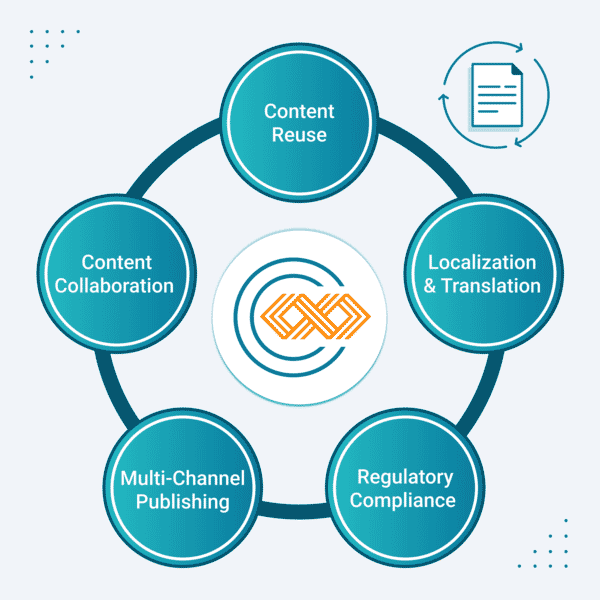This guest blog post was written by Val Swisher, Founder and CEO of Content Rules, Inc. Val is a recognized leader in content strategy, structured authoring, global content, and terminology management.
With a client list boasting industry giants like Google, Cisco, Visa, Facebook, Roche, and IBM, Val focuses on making content easy to read, cost-effective to create and translate, and efficient to manage.
Five Use Cases for Enterprise DITA Adoption and CCMS Integration
Managing and delivering content efficiently is essential for enterprises looking to stay competitive and meet customer expectations. There are two powerful tools that, when combined, have revolutionized the way content is managed, reused, and distributed. These two tools are DITA (Darwin Information Typing Architecture) and a CCMS (Component Content Management System).
DITA is an XML standard that enables consistent structures for your content. It is readable by humans and machines alike.
A CCMS enables you to store, manage, and publish content from a repository of modular components. These components can be used and reused in different ways to produce many outputs.
By implementing DITA XML and a CCMS, organizations can adopt structured content authoring more successfully. With structured content, an enterprise can deliver better content experiences at lower costs in less time.
Here are five key use cases for adopting DITA and integrating it with a CCMS across an enterprise.
1. Reuse
One of the primary challenges faced by content creators and organizations is the duplication of content across various outputs. Duplication of content leads to costly risks, such as:
- Inconsistencies – known as “content drift”
- Increases maintenance efforts
- Clutters search results.
- Reduces customers’ trust in the accurate variation (And – take it from me – neither do your authors. Which just causes them to create more redundant content.)
Organizations can reduce these risks and eliminate content drift by adopting structured content especially in technical information or documentation. This will allow organizations to take advantage of content reuse, enabled by DITA adoption and a CCMS integration. For instance, a topic on 'system diagnostics' can be used in many outputs:
- An installation guide describing how to set up monitoring tools
- A maintenance guide describing how to perform routine checks
- A troubleshooting guide describing how to diagnose and resolve issues
- An e-learning module describing how to perform system diagnostics
- A chatbot answer to a customer query about diagnosing a problem
The topic can also be served up to a customer on its own, if the customer is looking up the information in a knowledge base or chatbot. If a topic needs to be modified, the author changes the information one time, in the single topic. The change is then propagated to all of the outputs that use the topic. This saves time in technical communication and ensures that the content is exactly the same everywhere it is used.
This simple example demonstrates the effectiveness of component-based content for your authors and your customers.
2. Localization and Translation
For enterprises with a global reach, localization and translation of content are critical. DITA and a CCMS streamline the localization process by allowing you to manage content translations more efficiently. Individual DITA topics can be translated and reused across various documents, ensuring consistency and reducing translation costs. You do not need to send an entire document for translation simply because one small section changed.
Let's say your company operates in multiple countries, and you need to provide product information in different languages. With CCMS and DITA implementation, you can translate product descriptions, user guides, and marketing materials while maintaining a central repository of content. A topic is translated, reviewed, and approved one time. It can then be used and reused everywhere that information is needed in your global content outputs. Using DITA and a CCMS simplifies the localization process and helps you contain costs.
3. Regulatory Compliance
In highly regulated industries such as healthcare, finance, and pharmaceuticals, adhering to compliance standards is non-negotiable. DITA XML and a CCMS provide a robust framework for managing and ensuring regulatory compliance in your content.
For organizations in the healthcare, biotech, or pharmaceutical sectors, enhancing compliance and content efficiency further can be achieved by integrating a specialized pharmaceutical learning content management system. These systems are specifically designed to handle the complexities of managing highly regulated content, ensuring that all documentation not only complies with stringent regulatory standards but is also efficiently managed and easily accessible across the organization.
Ensuring traceability and maintaining a comprehensive version history of content is crucial, especially when collaboration involves multiple stakeholders. DITA and a CCMS provide robust traceability and version control features.
Imagine you're in the process of developing a critical regulated document. With DITA and a CCMS, you can track every change made to each topic within the document. The CCMS tracks who made the change, when the change was made, and why the change was made. Additionally, you can revert to previous versions if needed, ensuring content integrity and compliance.
This level of traceability at a granular level ensures transparency and accountability, making it easier for DITA users to meet regulatory requirements and address compliance concerns. For content that must be maintained for years or even decades, a CCMS is a must. Otherwise, the organization takes the risk that the rationale for changes is stored in someone’s head – someone who may not still be with the company when the regulatory body requires the information.

4. Multi-Channel Publishing
Content absolutely must be accessible across various platforms and devices. The days of producing just a printed document, or even a single static PDF, are long gone.
DITA content is created and stored in a format-neutral environment. Being format-neutral enables the same content to be repurposed for different output formats, such as web, mobile, PDF, and more.
In a DITA standard, the formatting is applied to the content as part of the publishing function. This means that you do not need to create a different version of the content for a mobile phone screen and a PDF file, for example. You can use the same topics to create the different output types.
Consider the need to deliver product documentation to customers. With DITA and a CCMS, you can create content once and publish it seamlessly to different channels. Whether customers prefer accessing documentation on a desktop, tablet, or mobile device, they can access the information in a format that suits them best.
If you are planning to deliver an omnichannel experience, a CCMS is a must. Only with modular content based on a consistent structure like DITA can the content delivery systems match the right content to the right place in the customer’s journey.
And you can still produce print documents, books, and manuals, from the same source of truth as the digital outputs. It’s a win for everyone.
5. Content Collaboration
Collaboration is a cornerstone of content creation in enterprises. Multiple team members, including subject matter experts, writers, and editors, often work on different parts of the same document. DITA and a CCMS facilitate seamless collaboration and content management.
The features of an enterprise-scale CCMS allow different content creators to work on different topics without affecting each other, even when those topics are in the same document
Imagine a scenario where your marketing team is creating a new product launch campaign. DITA allows team members to work on individual components like product descriptions, features, and benefits. The CCMS tracks changes, manages revisions, and ensures content approval, providing a controlled and collaborative environment. This not only improves efficiency but also maintains version control and content integrity.
Harnessing DITA and CCMS for Effective Content Management
Efficient content management and solid DITA experience are imperative for enterprises that strive to maintain a competitive edge and meet evolving customer demands. The combination of DITA and a CCMS presents a powerful solution to this challenge.
In this blog post, we've explored five key use cases highlighting the transformative power of DITA and CCMS integration in enterprise settings. To discover more about the DITA project and DITA best practices, download the What is Structured Content: Making the Case for XML eBook.
The combination of DITA and an enterprise CCMS offers a comprehensive solution for organizations that need to optimize content management, reduce costs, and ensure consistent, high-quality content delivery. These use cases illustrate how harnessing the power of DITA and CCMS can be a game-changer in the evolving landscape of content management.










